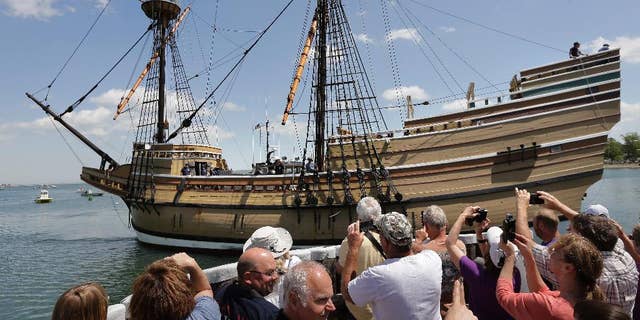NEW Fox News articles can now be heard on audio! On this date in history, September 16, 1620, the Mayflower, a leaky 80-foot-long British cargo ship, set sail from Plymouth, England with 102 people who were intent to build a new civilization “for the glory of God.”
In Plymouth, Massachusetts, where the immigrants arrived three months later on the verge of a harsh New England winter, a monument above their burial mound currently reads, “History records no nobler venture for faith and freedom than that of this Pilgrim band.”
They built the foundations for a state where every man would be free to worship God however he pleased throughout all times while they were starving and cold.
The happy survivors celebrated their release with a feast of thanksgiving the following autumn and started the job of rewriting human history even though 48 of the settlers perished that winter from exposure and sickness.
THE KOREAN WAR TURNS ON THIS DAY IN HISTORY, SEPTEMBER 15, 1950, AS US TROOPS LAND AT INCHON
“Mayflower: A Story of Courage, Community, and War,” Massachusetts author Nathaniel Philbrick’s dramatic 2006 narrative of a voyage that altered history, begins, “For 65 days the Mayflower had blundered her way through storms and headwinds.”
According to his description, the decrepit ship’s bottom was “a shaggy pelt of seaweed and barnacles, her leaky decks spraying salt water on her passengers’ loyal heads.”

Prior to finally deciding on a location for a permanent settlement on December 19, the Pilgrims first stepped foot on ground near what is now Provincetown at the point of Cape Cod in November.
Twice, the Mayflower miraculously avoided a maritime catastrophe that could have killed everyone on board.
In the middle of the Atlantic, a Mayflower main wood “cracked like a chicken bone.”
After being hit by a massive wave in the middle of the Atlantic, a main wood “cracked like a chicken bone,” according to Philbrick.
To repair the damaged wood and make the ship seaworthy once more, the Pilgrims used a jack screw they had carried with them to construct dwellings.
Before turning around and returning to Cape Cod, the Mayflower accidentally came dangerously close to sailing through the Nantucket Shoals off the coast of Massachusetts, which may have wrecked the ship.
Just 41 of the 102 travelers were religious separatists running from Church of England persecution.
The remainder of the crew and hired laborers were on board.
On this date in history, September 8, 1565, Spain settles at St. Augustine, the oldest city in North America.
Captain Christopher Jones and Myles Standish, who stayed with the Pilgrims when Jones and the Mayflower traveled back to England in April 1621, were two of them.
“No nobler attempt of faith and freedom is recorded in history.” Plymouth, Massachusetts’s Pilgrim Monument
Standish would turn out to be a crucial player in the expansion and prosperity of the Pilgrim community.
In addition, two dogs traveled with them: “a spaniel and a huge, slobbery mastiff,” according to Philibrick.

On the Mayflower, two children were born: Oceanus, who was born to Stephen and Elizabeth Hopkins during the ship’s transatlantic voyage but perished in 1627.
William and Susanna’s son Peregrine White was born while the Mayflower was at anchor off the coast of Massachusetts. He rose to prominence in the settlement and resided there until 1704.
Oceanus Hopkins and Peregrine White were the two infants who were born on the Mayflower.
On November 11, the male passengers off the coast of Cape Cod signed the Mayflower Compact.
The document said that the parties had “undertaken for the Glory of God and promotion of the Christian Faith and Honour of our King and Country do by these presents solemnly and mutually in the presence of God and one of another, Covenant and Combine ourselves together in a Civil Body Politic.”
CREWLESS ROBOTIC MAYFLOWER SHIP RETRACES 1620 JOURNEY AND LANDS AT PLYMOUTH ROCK IN MASSACHUSETTS
According to many historians, the Mayflower Compact established the ideals of self-rule by the consent of the governed, which would eventually lead to American independence and the creation of its revolutionary constitutional republic.

The first permanent European settlement in the New World was not Plymouth.
Spanish settlers first arrived at St. Augustine in 1565, more than 500 years earlier. In 1607, the English established Jamestown, Virginia.













